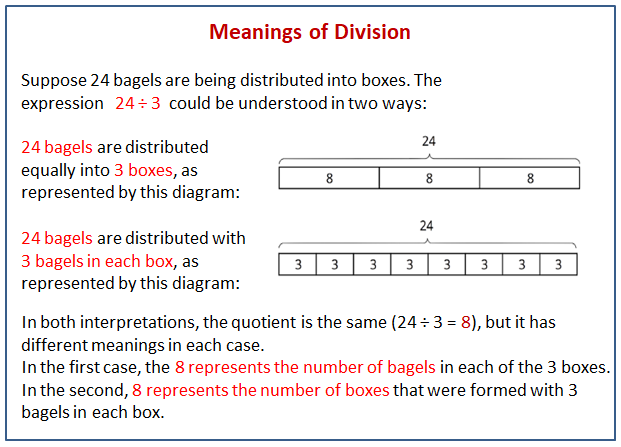Illustrative Mathematics Unit 6.4, Lesson 2: Meanings of Division
Learning Targets:
- I can explain how multiplication and division are related.
- I can explain two ways of interpreting a division expression such as 27 ÷ 3.
- When given a division equation, I can write a multiplication equation that represents the same situation.
Related Pages
Illustrative Math
Grade 6
Lesson 2: Meanings of Division
Let’s explore ways to think about division.
Illustrative Math Unit 6.4, Lesson 2 (printable worksheets)
Lesson 2 Summary
The following diagram shows how to reason about the size of the quotient by looking at the size of the dividend and the divisor.

These two ways of seeing division are related to how 3, 8, and 24 are related in multiplication. Both 3 · 8 and 8 · 3 equal 24.
3 · 8 = 24 can be read as “3 groups of 8 make 24.”
8 · 3 = 24 can be read as “8 groups of 3 make 24.”
If 3 and 24 are the only numbers given, the multiplication equations would be:
3 · ? = 24
? · 3 = 24
In both cases, the division 24 ÷ 3 can be used to find the value of the “?” But now we see that it can be interpreted in more than one way, because the “?” can refer to the size of a group (as in “3 groups of what number make 24?”), or to the number of groups (as in “How many groups of 3 make 24?”).
Lesson 2.1 A Division Expression
Here is an expression: 20 ÷ 4.
What are some ways to think about this expression? Describe at least two meanings you think it could have.
Lesson 2.2 Bags of Almonds
A baker has 12 pounds of almonds. She puts them in bags, so that each bag has the same weight.
- Clare and Tyler drew diagrams and wrote equations to show how they were thinking about 12 ÷ 6.
How do you think Clare and Tyler thought about 12 ÷ 6? Explain what each diagram and each part of each equation (especially the missing number) might mean in the context of the bags of almonds.
Pause here for a class discussion. - Explain what each division expression could mean in the context of the bags of almonds. Then draw a diagram and write a multiplication equation to show how you are thinking about the expression.
a. 12 ÷ 4
b. 12 ÷ 2
c. 12 ÷ ½
Are you ready for more?
A loaf of bread is cut into slices.
- If each slice is of a loaf, how many slices are there?
- If each slice is of a loaf, how many slices are there?
- What happens to the number of slices as each slice gets smaller?
- Interpret the meaning of dividing by 0 in the context of slicing bread.
Lesson 2 Practice Problems
- Twenty pounds of strawberries are being shared equally by a group of friends. The equation 20 ÷ 5 = 4 represents the division of strawberries.
a. If the 5 represents the number of people, what does the 4 represent?
b. If the 5 represents the pounds of strawberries per person, what does the 4 represent? - A sixth-grade science club needs $180 to pay for the tickets to a science museum. All tickets cost the same amount.
What could 180 ÷ 15 mean in this context? Describe two interpretations of the expression. Then, find the quotient and explain what it means in each interpretation. - Write a multiplication equation that corresponds to each division equation.
a. 10 ÷ 5 = ?
b. 4.5 ÷ 3 = ?
c. ½ ÷ 4 = ? - Write a division or multiplication equation that represents each situation. Use a “?” for the unknown quantity.
a. 2.5 gallons of water are poured into 5 equally sized bottles. How much water is in each bottle?
b. A large bucket of 200 golf balls is divided into 4 smaller buckets. How many golf balls are in each small bucket?
c. Sixteen socks are put into pairs. How many pairs are there? - Find a value for that makes each statement true.
a. a ÷ 6 is greater than 1
b. a ÷ 6 is equal to 1
c. a ÷ 6 is less than 1
d. a ÷ 6 is equal to a whole number - Complete the table. Write each percentage as a percent of 1.
| fraction | decimal | percentage |
| ¼ | 0.25 | 25% of 1 |
| 0.1 | ||
| 75% of 1 | ||
| ⅕ | ||
| 1.5 | ||
| 140% of 1 |
The Open Up Resources math curriculum is free to download from the Open Up Resources website and is also available from Illustrative Mathematics.
Try out our new and fun Fraction Concoction Game.
Add and subtract fractions to make exciting fraction concoctions following a recipe. There are four levels of difficulty: Easy, medium, hard and insane. Practice the basics of fraction addition and subtraction or challenge yourself with the insane level.

We welcome your feedback, comments and questions about this site or page. Please submit your feedback or enquiries via our Feedback page.
